
The Richard Wall house, built 1682, is a historic home in Elkins Park, Pennsylvania. It had continuous Wall family residency for over 150 years, having been in the Wall family and its descendants through 1847. It is listed in the National Register of Historic Places as "Wall House" also known as "The Ivy".

The 1696 Thomas Massey House is one of the oldest English Quaker homes in the Commonwealth of Pennsylvania. It is a 2-story brick and stone house, originally constructed by the English, Quaker settler, Thomas Massey in 1696. It is located on Lawrence Road near Sproul Road in Broomall, Pennsylvania.

The Gen. Horatio Gates House and Golden Plough Tavern are two connecting historic buildings which are located in downtown York, York County, Pennsylvania. The buildings were restored between July 1961 and June 1964, and operated as a museum by the York County History Center.

The U.S. Customshouse is a historic customs house and United States Coast Guard museum on Cobbs Hill in Barnstable, Massachusetts. Built in 1855 to a design by Ammi Young, it was used as a custom house and post office until 1913, continuing to house the post office and other offices until 1958. It was converted into a museum in 1960, and was listed on the National Register of Historic Places in 1975.

The Cashier's House is a three-story stuccoed-brick, Greek Revival building located on State Street in Erie, Pennsylvania. It was documented by the Historic American Buildings Survey in 1934. The house was listed on the National Register of Historic Places on January 13, 1972, and its boundary was increased on March 9, 1983.

Fort Gaddis is the oldest known building in Fayette County, Pennsylvania and the second oldest log cabin in Western Pennsylvania. It is located 300 yards (270 m) east of old U.S. Route 119, near the Route 857 intersection in South Union Township, Fayette County, Pennsylvania. Fort Gaddis was built about 1769-74 by Colonel Thomas Gaddis who was in charge of the defense of the region, and his home was probably designated as a site for community meetings and shelter in times of emergency, hence the term "Fort Gaddis," probably a 19th-century appellation. It is a 1 1/2-story, 1-room log structure measuring 26 feet long and 20 feet wide.

Birmingham Friends Meetinghouse is a historic Quaker meeting house at 1245 Birmingham Road in Birmingham Township, Chester County, Pennsylvania. The current meetinghouse was built in 1763. The building and the adjacent cemetery were near the center of fighting on the afternoon of September 11, 1777 at the Battle of Brandywine. Worship services are held weekly at 10am. The meetinghouse and adjacent octagonal schoolhouse were listed on the National Register of Historic Places as Birmingham Friends Meetinghouse and School on July 27, 1971.

Catawissa Friends Meetinghouse is a historic Quaker meetinghouse at South and 3rd Streets in Catawissa, Columbia County, Pennsylvania. It was built about 1789, and is a one-story log building on a stone foundation. It measures 30 feet by 27 feet, 6 inches.

The Ebenezer Maxwell House, operated today as the Ebenezer Maxwell Mansion, is an historic house located in the West Germantown neighborhood of Philadelphia, Pennsylvania.

Cement City Historic District is a historic district in Donora, Pennsylvania. The district includes 80 Prairie School concrete residences built in 1916–17. The homes served as housing for employees of the American Steel and Wire Company. Poured-in-place concrete houses had become popular in large-scale housing developments at the time, partly thanks to promotion by Thomas Edison; the homes built in Donora used a newly patented construction method from the Lambie Concrete House Corporation. Building the houses required a combined 10,000 barrels of Portland cement.
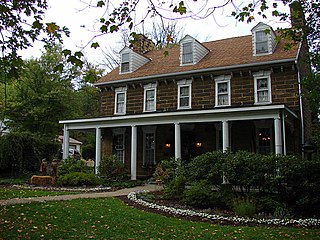
Hill's Tavern is a historic building in Scenery Hill, Pennsylvania. It was heavily damaged by a fire that started shortly before midnight on August 17, 2015. For a period in the early 1900s, the inn was known as Central Hotel. Now called the Century Inn, it has been claimed to have been the oldest tavern in continuous use on the National Road, until the fire brought an end to its 221 years of continuous operation.

The Lower Swedish Cabin is a historic Swedish-style log cabin which is located on Creek Road in the Drexel Hill section of Upper Darby, Pennsylvania, along Darby Creek. The cabin may be one of the oldest log cabins in the United States and is one of the last cabins built by the Swedish settlers that remains intact.

The Adams County Courthouse is located in Gettysburg, Pennsylvania. It was added to the National Register of Historic Places on October 1, 1974.
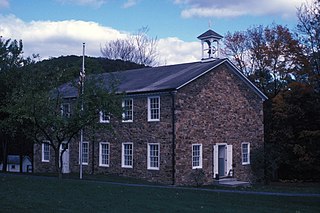
The Tuscarora Academy in Academia, Pennsylvania is a building from 1816. It was listed on the National Register of Historic Places in 1972. The building was constructed in 1816 as a Presbyterian Church. When the Tuscarora Academy was established in 1836, some of the classes were held in the church. Other campus buildings were adjacent to the property. In 1850 the academy trustees purchased the building and added the second floor for extra dormitory rooms. From 1851 until 1875, four fires on campus destroyed the other campus buildings. Academy classes continued in this stone building until 1912, then until 1916 the building was used for Beale Township High School. Alumni and community members lobbied hard for the building's restoration and preservation, which finally happened starting in the 1960s. In August 1970, the Tuscarora Academy Museum opened to the public and is still operational today. In 2016, ownership was transferred to the Juniata County Historical Society. The Museum is open June through August on Sundays from 1:30pm until 4:00pm.

Etna Furnace, also known as Mount Etna Furnace, Aetna Furnace, and Aetna Iron Works, is a historic iron furnace complex and national historic district located at Catharine Township, Blair County, Pennsylvania. The district includes five contributing buildings, six contributing sites, and two contributing structures. It encompasses a community developed around an iron furnace starting in 1805. Included in the district is the four-sided stone furnace (1808), gristmill site, canal locks, site of lock keeper's house, aqueduct, two small houses, the ruins of a charcoal house (1808), the foundation of a tally house, a blacksmith shop, bank barn, foundation of a boarding house, three family tenant house, two iron master' mansions, a store and paymaster's office, Methodist / Episcopal Church (1860), and cemetery with graves dating between 1832 and 1859.
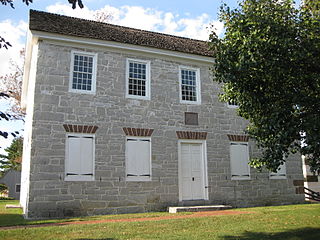
The Peace Church, also known as Die Frieden Kirche, is an historic, American Reformed and Lutheran church that is located in Hampden Township, Cumberland County, Pennsylvania.
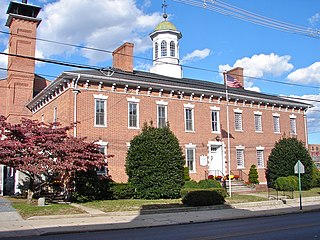
The Old Franklin County Jail is a historic jail located at Chambersburg in Franklin County, Pennsylvania. It was built in 1818, and is a two-story, brick building with a slate covered hipped roof topped by a cupola. The original building measures 84 feet wide by 48 feet deep. In 1880, a cell block was added. The jail yard is divided into two sections and surrounded by a 20-foot-high wall. At least seven prisoners were hanged on the premises.
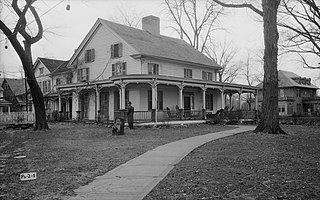
Denison House, also known as the Colonel Nathan Denison House, is a historic home located at Forty Fort, Luzerne County, Pennsylvania. It was built about 1790, and is a 2+1⁄2-story, frame building with a central chimney in the New England style. A rear addition and full-width front porch were added in the mid-19th century. The house has since been restored to its appearance in the 1790s.

Pottsgrove Manor, also known as the John Potts House, is an historic, American home that is located in Pottstown, Montgomery County, Pennsylvania.

The Henry Fisher House is an historic, American home that is located in Oley Township, Berks County, Pennsylvania.
























